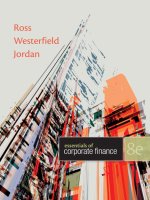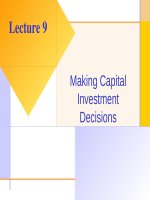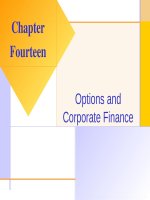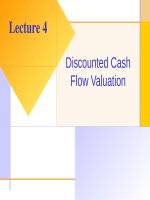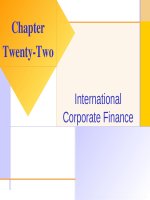Lecture Essentials of corporate finance (2/e) – Chap 7: Equity markets and stock valuation
Bạn đang xem bản rút gọn của tài liệu. Xem và tải ngay bản đầy đủ của tài liệu tại đây (611.67 KB, 41 trang )
Equity markets and share
valuation
Chapter 7
Key concepts and skills
• Understand how stock prices depend
on future dividends and dividend
growth
• Be able to compute stock prices using
the dividend growth model
• Understand how corporate directors
are elected
• Understand how stock markets work
• Understand how stock prices are
quoted
Copyright 2011 McGraw-Hill Australia Pty Ltd
PPTs t/a Essentials of Corporate Finance 2e by Ross et al.
Slides prepared by David E. Allen and Abhay K. Singh
7-2
Chapter outline
• Ordinary share valuation
• Some features of ordinary and
preference shares
• The share markets
Copyright 2011 McGraw-Hill Australia Pty Ltd
PPTs t/a Essentials of Corporate Finance 2e by Ross et al.
Slides prepared by David E. Allen and Abhay K. Singh
7-3
Cash flows for stockholders
• If you own a share of stock, you can
receive cash in two ways:
1. The company pays dividends.
2. You sell your shares, either to another
investor in the market or back to the company.
• As with bonds, the price of the stock is the
present value of these expected cash
flows.
– Dividends → cash income
– Selling → capital gains
Copyright 2011 McGraw-Hill Australia Pty Ltd
PPTs t/a Essentials of Corporate Finance 2e by Ross et al.
Slides prepared by David E. Allen and Abhay K. Singh
7-4
One-period example
• Suppose you are thinking of purchasing
the stock of Moore Oil Inc.
– You expect it to pay a $2 dividend in one
year.
– You believe you can sell the stock for $14
at that time.
– You require a return of 20% on
investments of this risk.
– What is the maximum you would be willing
to pay?
Copyright
2011 McGraw-Hill Australia Pty Ltd
PPTs t/a Essentials of Corporate Finance 2e by Ross et al.
Slides prepared by David E. Allen and Abhay K. Singh
7-5
One-period example (cont.)
•
D1 = $2 dividend expected in one year
•
•
R = 20%
P1 = $14
•
CF1 = $2 + $14 = $16
•
Compute the PV of the expected cash flows
P0
•
•
( 2 14 )
1.20
$13.33
Calculator:
16 [FV]; 20 [I/Y]; 1 [N]; [CPT] [PV] = -13.33
Copyright 2011 McGraw-Hill Australia Pty Ltd
PPTs t/a Essentials of Corporate Finance 2e by Ross et al.
Slides prepared by David E. Allen and Abhay K. Singh
7-6
Two-period example
•
•
Now, what if you decide to hold the share for two years?
In addition to the dividend in one year, you expect a
dividend of $2.10 and a share price of $14.70 at the end of
year 2. Now how much would you be willing to pay?
P0
•
2
1.20
( 2.10 14.70 )
(1.20 )2
$13.33
•
Calculator:
CF0 = 0; C01 = 2; F01 = 1; C02 = 16.80; F02 = 1;
•
[NPV]; I = 20; [CPT][NPV] = $13.33
Copyright 2011 McGraw-Hill Australia Pty Ltd
PPTs t/a Essentials of Corporate Finance 2e by Ross et al.
Slides prepared by David E. Allen and Abhay K. Singh
7-7
Three-period example
• What if you decide to hold the stock for three years?
• In addition to the dividends at the end of years 1 and 2,
you expect to receive a dividend of $2.205 at the end of
year 3 and a share price of $15.435.
• Now how much would you be willing to pay?
P0
2
1.20
2.10
(1.20)2
( 2.205 15.435 )
(1.20)3
$13.33
• Calculator:
• CF0 = 0; C01 = 2; F01 = 1; C02 = 2.10; F02 = 1;
C03 = 17.64; F03 = 1;
• [NPV]; I = 20; [CPT] [NPV] = $13.33
Copyright 2011 McGraw-Hill Australia Pty Ltd
PPTs t/a Essentials of Corporate Finance 2e by Ross et al.
Slides prepared by David E. Allen and Abhay K. Singh
7-8
Developing the model
• You could continue to push back when
you would sell the share.
• You would find that the price of the
share is really just the present value of
all expected future dividends.
Copyright 2011 McGraw-Hill Australia Pty Ltd
PPTs t/a Essentials of Corporate Finance 2e by Ross et al.
Slides prepared by David E. Allen and Abhay K. Singh
7-9
Stock value = PV of
dividends
P0 =
D1
D1∞ +
(1+R)
D2
D3
(1+R)2
(1+R)3
+
(1+R)∞
P0
t 1
+…+
Dt
t
(1 R )
How can we estimate all future dividend
payments?
Copyright 2011 McGraw-Hill Australia Pty Ltd
PPTs t/a Essentials of Corporate Finance 2e by Ross et al.
Slides prepared by David E. Allen and Abhay K. Singh
7-10
Estimating dividends:
Special cases
• Constant dividend
– The firm will pay a constant dividend forever
– This is like a preference share
– The price is computed using the perpetuity
formula
• Constant dividend growth
– The firm will increase the dividend by a
constant percentage every period
• Supernormal growth
– Dividend growth is not consistent initially, but
settles down to constant growth eventually
Copyright 2011 McGraw-Hill Australia Pty Ltd
PPTs t/a Essentials of Corporate Finance 2e by Ross et al.
Slides prepared by David E. Allen and Abhay K. Singh
7-11
Zero growth
• If dividends are expected at regular
intervals forever, this is like a
preference share and is valued as a
perpetuity
– P0 = D/R
• Suppose a share is expected to pay a
$0.50 dividend every half-year and the
required return is 10% with half-yearly
compounding. What is the price?
– P0 = .50 / (0.1 / 2) = $10
Copyright 2011 McGraw-Hill Australia Pty Ltd
PPTs t/a Essentials of Corporate Finance 2e by Ross et al.
Slides prepared by David E. Allen and Abhay K. Singh
7-12
Constant growth stock
• Dividends are expected to grow at a
constant percentage per period.
– D1 = D0(1+g)1
– D2 = D0(1+g)2
– Dt = Dt(1+g)t
– D0 = Dividend JUST PAID
– D1 – Dt = Expected dividends
Copyright 2011 McGraw-Hill Australia Pty Ltd
PPTs t/a Essentials of Corporate Finance 2e by Ross et al.
Slides prepared by David E. Allen and Abhay K. Singh
7-13
Dividend growth model
(DGM)
P0 = D1 /(1+R) + D2 /(1+R)2 + D3 /(1+R)3 + …
P0 = D0(1+g)/(1+R) + D0(1+g)2/(1+R)2 +
D0(1+g)3/(1+R)3 + … (‘with a constant dividend growth’
g)
P0
D0
t
P0
1
g )t
R)t
(1
(1
D 0 (1 g)
R g
D1
R g
Copyright 2011 McGraw-Hill Australia Pty Ltd
PPTs t/a Essentials of Corporate Finance 2e by Ross et al.
Slides prepared by David E. Allen and Abhay K. Singh
7-14
DGM—Example 1
• Suppose Outback Ltd just paid a dividend
of $0.50. It is expected to increase its
dividend by 2% per year. If the market
requires a return of 15% on assets of this
risk, how much should the share be selling
for?
D0 (1 g)
P0
• D0= $0.50
R g
• g = 2%
• R = 15%
0.50(1 .02)
P0
.15 .02
Copyright 2011 McGraw-Hill Australia Pty Ltd
PPTs t/a Essentials of Corporate Finance 2e by Ross et al.
Slides prepared by David E. Allen and Abhay K. Singh
$3.92
7-15
DGM—Example 2
• Suppose Deep Pirates Ltd is expected to
pay a $2 dividend in one year. If the
dividend is expected to grow at 5% per
year and the required return is 20%, what
is the price?
D1
P0
– D1 = $2.00
R
g
– g = 5%
– r = 20%
P0
2.00
.20 .05
Copyright 2011 McGraw-Hill Australia Pty Ltd
PPTs t/a Essentials of Corporate Finance 2e by Ross et al.
Slides prepared by David E. Allen and Abhay K. Singh
$13.33
7-16
Share price sensitivity to
dividend growth (g)
250
D1 = $2; R = 20%
Stock Price
200
150
100
50
0
0
0.05
0.1
0.15
0.2
Growth Rate
Copyright 2011 McGraw-Hill Australia Pty Ltd
PPTs t/a Essentials of Corporate Finance 2e by Ross et al.
Slides prepared by David E. Allen and Abhay K. Singh
7-17
Share price sensitivity to
required return (R)
250
D1 = $2; g = 5%
Stock Price
200
150
100
50
0
0
0.05
0.1
0.15
0.2
0.25
0.3
Growth Rate
Copyright 2011 McGraw-Hill Australia Pty Ltd
PPTs t/a Essentials of Corporate Finance 2e by Ross et al.
Slides prepared by David E. Allen and Abhay K. Singh
7-18
Example 7.3—Gordon Growth
Company I
•
•
•
Gordon Growth Company is expected to pay a dividend of $4
next period and dividends are expected to grow at 6% per
year. The required return is 16%.
What is the current price?
P0
D1
R g
P0
4.00
.16 .06
$40
Remember that we already have the dividend expected next
year, so we don’t multiply the dividend by 1+g.
Copyright 2011 McGraw-Hill Australia Pty Ltd
PPTs t/a Essentials of Corporate Finance 2e by Ross et al.
Slides prepared by David E. Allen and Abhay K. Singh
7-19
Example 7.3—Gordon Growth
Company II
• What is the price expected to be in
year 4?
– P4 = D4(1 + g) / (R – g) = D5 / (R – g)
– P4 = 4(1+.06)4 / (.16 - .06) = 50.50
• What is the implied return given the
change in price during the 4-year
period?
– 50.50 = 40(1+return)4; return = 6%
– -40[PV]; 50.50[FV]; 4[N]; [CPT][I/Y] = 6%
• The price grows at the same rate as
the dividends.
Copyright 2011 McGraw-Hill Australia Pty Ltd
PPTs t/a Essentials of Corporate Finance 2e by Ross et al.
Slides prepared by David E. Allen and Abhay K. Singh
7-20
Constant growth model
conditions
1. Dividend expected to grow at g forever.
2. Stock price expected to grow at g
forever.
3. Expected dividend yield is constant.
4. Expected capital gains yield is constant
and equal to g.
5. Expected total return, R, must be > g.
6. Expected total return (R):
= expected dividend yield (DY)
+ expected growth rate (g)
= dividend yield + g
Copyright 2011 McGraw-Hill Australia Pty Ltd
PPTs t/a Essentials of Corporate Finance 2e by Ross et al.
Slides prepared by David E. Allen and Abhay K. Singh
7-21
Non-constant growth problem
statement
• Suppose a firm is expected to increase
dividends by 20% in one year and by
15% in two years. After that dividends
will increase at a rate of 5% per year
indefinitely. If the last dividend was $1
and the required return is 20%, what is
the price of the share?
• Remember that we have to find the PV
of all expected future dividends.
Copyright 2011 McGraw-Hill Australia Pty Ltd
PPTs t/a Essentials of Corporate Finance 2e by Ross et al.
Slides prepared by David E. Allen and Abhay K. Singh
7-22
Non-constant growth problem
—Solution
• Compute the dividends until growth
levels off
– D1 = 1(1.2) = $1.20
– D2 = 1.20(1.15) = $1.38
– D3 = 1.38(1.05) = $1.449
• Find the expected future price
– P2 = D3 / (R – g) = 1.449 / (.2 - .05) = $9.66
• Find the present value of the expected
future cash flows
– P0 = 1.20 / (1.2) + (1.38 + 9.66) / (1.2)2 =
Copyright 2011 McGraw-Hill Australia Pty Ltd
$8.67
PPTs t/a Essentials of Corporate Finance 2e by Ross et al.
Slides prepared by David E. Allen and Abhay K. Singh
7-23
Non-constant + Constant
growth
• Basic PV of all future dividends formula
P0
D1
1 R
D2
1 R
1
2
D3
1 R
3
. . .
D
1 R
Dividend growth model
Pt
Dt 1
R
g
Copyright 2011 McGraw-Hill Australia Pty Ltd
PPTs t/a Essentials of Corporate Finance 2e by Ross et al.
Slides prepared by David E. Allen and Abhay K. Singh
7-24
Non-constant + Constant
growth (cont.)
P0
D1
1 R
1
Because
D2
1 R
P2
t
2
P2
2
(1 R )
Dt
t
(
1
R
)
3
If g constant after t 2, then
D3
P2
R g
Copyright 2011 McGraw-Hill Australia Pty Ltd
PPTs t/a Essentials of Corporate Finance 2e by Ross et al.
Slides prepared by David E. Allen and Abhay K. Singh
7-25



